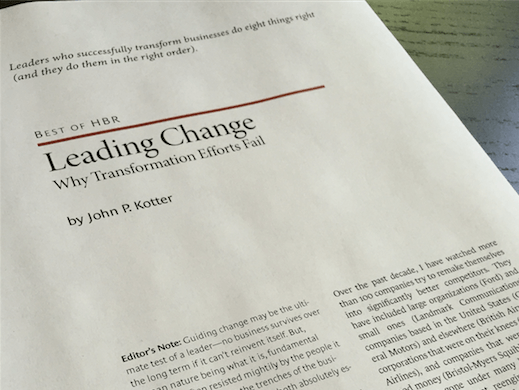Storytelling: A Powerful Tool for Successfully Leading Change
Change is hard.
When was the last time you tried changing something in your life? Your exercise routine, your diet, or your career? Did it work? From shifting my exercise schedule to cutting down on coffee, I have personally found it challenging to change my habits.
The process of change is so much more complex on an organizational scale. Because in order to change, you have to reinvent processes while forging new paths of thought and behavior.

Leading Change
Harvard Business School professor John P. Kotter has done tons of research on business strategy, leadership, and change. In his classic article, Leading Change: Why Transformation Efforts Fail, Kotter maps his eight steps for leading change, and the critical errors that block change efforts.
Over the years Kotter has seen dozens of corporations attempt to reinvent themselves. Many have failed. Fewer have succeeded. Based on his experience, he identified a process that organizations must go through to complete a successful change effort, and eight critical mistakes that they must avoid along the way.
The eight critical mistakes are:
1. Not establishing a great enough sense of urgency
2. Not creating a powerful enough guiding coalition
3. Lacking a vision
4. Undercommunicating the vision by a factor of ten
5. Not removing obstacles to the new vision
6. Not systematically planning for and creating short-term wins
7. Declaring victory too soon
8. Not anchoring changes in the corporation’s culture
See, it’s not easy to change. That’s why New Kind works with companies that want to reinvent, refresh, or change something about their brand. And we especially love helping organizations overcome Error 3 and Error 4. Because when a brand has a clear, compelling story that articulates a vision, and a strategy for communicating that story, it’s a beautiful thing. The rest of the process clicks into place more easily when the people inside and around the organization are all working in alignment toward the same goal. A goal that inspires them. A vision they all believe in.
Kotter writes, “In every successful transformation effort that I’ve seen, the guiding coalition develops a picture of the future that is relatively easy to communicate and appeals to customers, stockholders, and employees. A vision always goes beyond the numbers that are typically found in five-year plans.”
“A useful rule of thumb,” he writes, “If you can’t communicate the vision to someone in five minutes or less and get a reaction that signifies both understanding and interest, you are not yet done with this phase of the transformation process.”
But how do you create a vision and message that quickly resonates with stakeholders, and motivates change?
The Journey and the Destination
Our motto when we work with clients is, “when you bring people along on the journey, they’re more likely to accept the destination.” In other words, when you include stakeholders and the people who love your brand in the process of creating the vision, it will be much easier to communicate it in a way that they understand and find interesting.
One of the ways we like to include brand communities in the process is through surveys, interviews, and research that help us uncover individual stories. We ask open-ended questions like, “What’s your most memorable experience with this brand?” and “What do you value most (or least) about this brand?” We collect and analyze these stories. We seek to understand community perceptions about the brand, and the themes that connect individual stories to a greater whole. Then we can mold the ideas from the community into a vision that can push the organization toward its highest, most authentic potential, while staying rooted in its legacy.
Are you looking to create change within your organization? Start by listening. Collect stories from customers and employees. Use their insights to inspire your vision. Your community will recognize their role in the journey. And when you communicate the vision back to them, they’ll be more likely to understand and embrace the change you hope to lead.